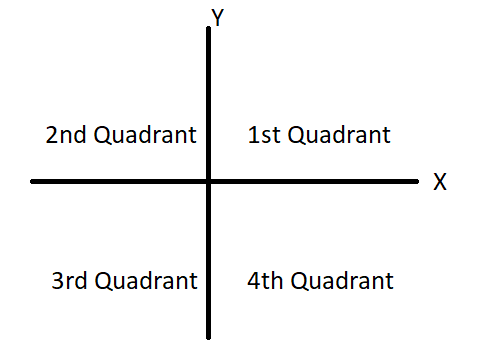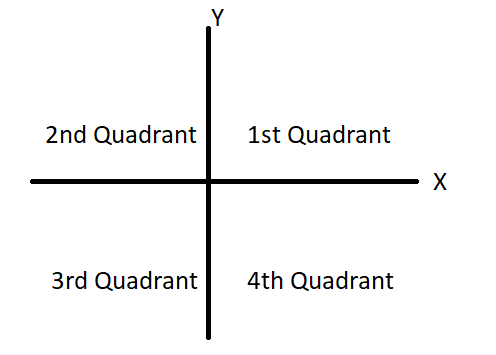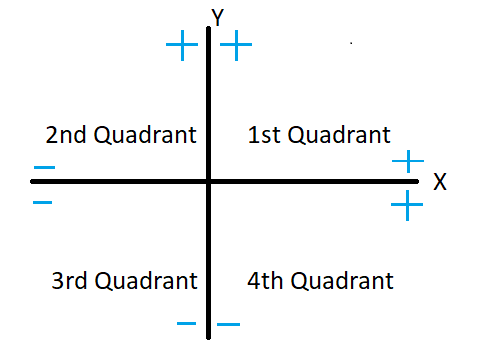
The diagram shows all the four quadrants in a Cartesian Plane.
Which of the following points below lies in \[3rd\] quadrant?
\[A( - 4,2)B(4,2)C(3, - 5)D( - 5, - 2)\]


Answer
510.9k+ views
Hint: We are given four different points out of which we have to identify which point lies in the third quadrant. If the two coordinates are in the form of \[(x,y)\], the points will lie in the third quadrant only if both coordinate values are negative i.e. \[( - x, - y)\].
Complete step by step solution:
The Cartesian plane creates four quadrants (I, II, III, IV).
We are given the diagram that shows all the four quadrants in a Cartesian Plane.
The points lies in \[3rd\] quadrant: \[A( - 4,2)B(4,2)C(3, - 5)D( - 5, - 2)\]

The coordinate point \[(x,y)\] on the Cartesian plane informs us about the horizontal distance of the point from the origin , and the vertical distance is \[y\]. If the sign of \[x\] is positive, the point is on the right of the origin; else it is on the left. Similarly, if the sign is positive for \[y\], the point is \[y\] points above the origin else it is \[y\] points below it.
Following points should be kept in mind about the points falling in the quadrants:
Quadrant I= Both the \[(x,y)\] coordinates are positive.
Quadrant II=Coordinate \[x\] is negative while coordinate \[y\] is positive.
Quadrant III= Both the \[(x,y)\] coordinates are negative.
Quadrant IV=Coordinate \[x\] is positive while coordinate \[y\] is negative.
It can be shown diagrammatically as follows:

It shows the positive and negative sign of coordinates falling in the four quadrants.
Now we can solve the question:
Out of all the points, only point \[D\] has both negative coordinates.
Hence, \[D( - 5, - 2)\] lies in the third quadrant.
The points given in the question can be plotted on the Cartesian plane as follows:

Note:
The Cartesian plane is defined as a two-dimensional coordinate plane, which is formed by the intersection of the \[X\]-axis and \[Y\]-axis.
The \[X\]-axis and \[Y\]-axis intersect perpendicular to each other at the point called the origin.
Complete step by step solution:
The Cartesian plane creates four quadrants (I, II, III, IV).
We are given the diagram that shows all the four quadrants in a Cartesian Plane.
The points lies in \[3rd\] quadrant: \[A( - 4,2)B(4,2)C(3, - 5)D( - 5, - 2)\]

The coordinate point \[(x,y)\] on the Cartesian plane informs us about the horizontal distance of the point from the origin , and the vertical distance is \[y\]. If the sign of \[x\] is positive, the point is on the right of the origin; else it is on the left. Similarly, if the sign is positive for \[y\], the point is \[y\] points above the origin else it is \[y\] points below it.
Following points should be kept in mind about the points falling in the quadrants:
Quadrant I= Both the \[(x,y)\] coordinates are positive.
Quadrant II=Coordinate \[x\] is negative while coordinate \[y\] is positive.
Quadrant III= Both the \[(x,y)\] coordinates are negative.
Quadrant IV=Coordinate \[x\] is positive while coordinate \[y\] is negative.
It can be shown diagrammatically as follows:

It shows the positive and negative sign of coordinates falling in the four quadrants.
Now we can solve the question:
Out of all the points, only point \[D\] has both negative coordinates.
Hence, \[D( - 5, - 2)\] lies in the third quadrant.
The points given in the question can be plotted on the Cartesian plane as follows:

Note:
The Cartesian plane is defined as a two-dimensional coordinate plane, which is formed by the intersection of the \[X\]-axis and \[Y\]-axis.
The \[X\]-axis and \[Y\]-axis intersect perpendicular to each other at the point called the origin.
Recently Updated Pages
Questions & Answers - Ask your doubts

A man running at a speed 5 ms is viewed in the side class 12 physics CBSE

State and explain Hardy Weinbergs Principle class 12 biology CBSE

Which of the following statements is wrong a Amnion class 12 biology CBSE

Two Planoconcave lenses 1 and 2 of glass of refractive class 12 physics CBSE

The compound 2 methyl 2 butene on reaction with NaIO4 class 12 chemistry CBSE

Trending doubts
Which places in India experience sunrise first and class 9 social science CBSE

Fill the blanks with the suitable prepositions 1 The class 9 english CBSE

Write the 6 fundamental rights of India and explain in detail

Difference Between Plant Cell and Animal Cell

What is the Full Form of ISI and RAW

Golden Revolution is related to AFood production BOil class 9 social science CBSE




